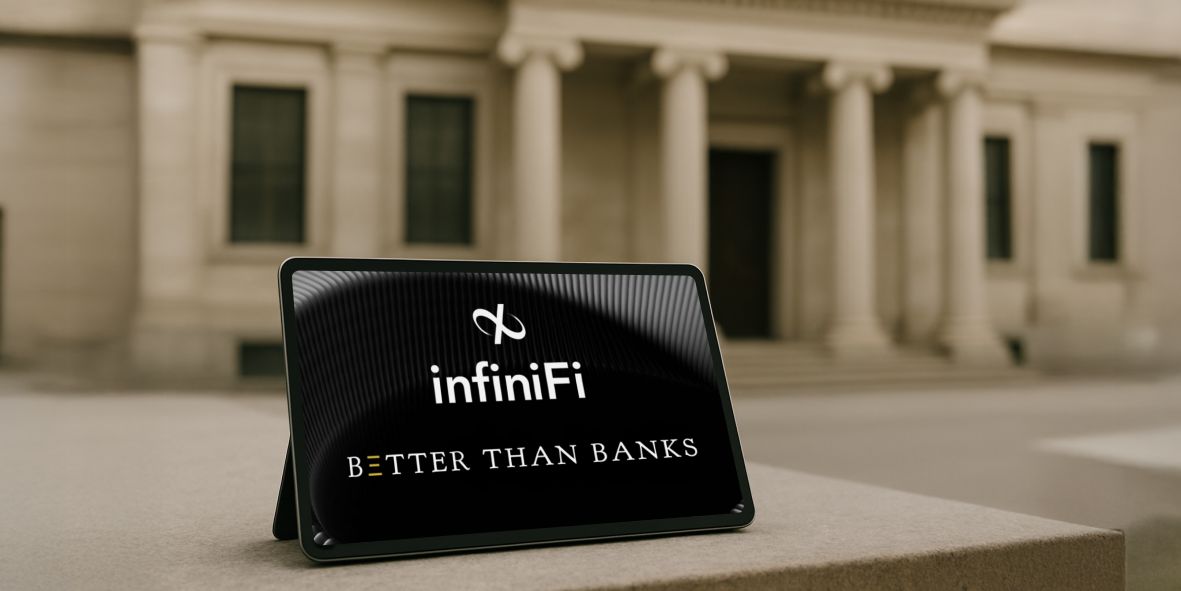Key Takeaways:
- Onchain fractional banking: InfiniFi replicates bank-like liquidity multiplication with iUSD/siUSD/liUSD tokens
- Radical transparency: Real-time reserve tracking replaces quarterly bank reports
- Loss waterfall protection: Locked liUSD holders absorb risks first
- FLF innovation: Combines Aave, Pendle, and Ethena for recursive yield strategies
Banking’s Fatal Flaw Meets Blockchain Fix
According to the Federal Deposit Insurance Corporation (FDIC), the $548B bank collapse in 2023 (five bank failures in the U.S.) revealed the fundamental fragility of fractional reserve banking; thus, InfiniFi is underway toward a new model on the Ethereum blockchain. The InfiniFi protocol whitepaper describes the underlying issue of mismatch duration (when a bank cannot cover sudden withdrawals). InfiniFi proposes a decentralized autonomous balance sheet in which depositors self-select their level of risk through one of three tokens:
1️⃣ iUSD (base stablecoin)
2️⃣ siUSD (liquid, lower yield)
3️⃣ liUSD (locked, higher yield)
Traditional banks guess depositor behavior while InfiniFi lets users declare it, explains the project’s documentation.
How Onchain Fractional Banking Works
InfiniFi’s model improves traditional banking in three key ways:
| FEATURE | TRADITIONAL BANKS | InfiniFi |
| Transparency | Quarterly call reports | Real-time blockchain verification |
| Risk Allocation | Opaque, bank-decided | User-chosen (siUSD vs liUSD) |
| Crisis Response | FDIC insurance delays | Coded loss waterfall |
The protocol’s $33M Total Value Locked (TVL) already deploys across:
The Fractional Liquidity Flywheel (FLF): DeFi’s Money Multiplier
InfiniFi’s secret weapon is integrating Aave + Pendle + Ethena to create a crypto-native fractional reserve system:
- Deposit $100 into Ethena → earn yield as sUSDe
- Lock in fixed rates via Pendle’s yield tokens
- Borrow against positions on Aave at 90% Loan-to-Value (LTV)
- Repeat → $100 becomes $1,000 in synthetic liquidity
When could we ever use this without InfiniFi? This isn’t magic, this is what banks do every day, just with smart contracts standing in for the auditors.
Moreover, the protocol also incentivizes users with its infiniFi Points Program, as announced through their official X account:
Why This Matters for Crypto’s Future
InfiniFi represents a philosophical shift:
✅ For Traditional Finance (TradFi): Demonstrates how blockchain solves banking’s opacity problems
✅ For Decentralized Finance (DeFi): Introduces sophisticated risk management beyond overcollateralization
✅ For Regulators: Provides a test case for on-chain reserve requirements
Banks 2.0 or Cautionary Tale?
As InfiniFi’s points program pulls in more deposits, the critical question remains: Is transparent fractional banking capable of preventing crises, or are the risks of smart contracts capable of creating new modes of failures? One thing is clear: with the recent bank collapses of 2023, the world seems primed to try something new.
Final Thought: Is this a substitute for traditional savings accounts?
For yield-chasers? Maybe. But not for FDIC believers, until there is “smart contract insurance.“
For more DeFi news, read: Is Mutuum Finance (MUTM) Legit or a Potential Scam? Presale Boom + Project Review







